Pelegrina flavipedes
Introduction
The handsomely-striped yellow and brown males of flavipedes are distinguished from flaviceps and most exigua by the strong cheek band, three white spots above anterior eyes, narrow carapace, smaller medial black spot on the chelicerae, and lack of bulbous head. The striped form of exigua might be confused for flavipedes except by the much broader retrolateral ramus of the embolus of flavipedes. The females have a brassy sheen distinguishing them from other northern Pelegrina. P. flavipedes females differ from flaviceps females in being darker and having a narrower, more obliquely directed second curve of the epigynal ducts; they differ from exigua females in having more parallel epigynal flaps and a much narrower second curve of the epigynal ducts.
Figures

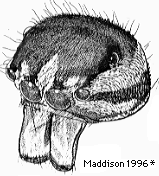 1
1
 2
2
 3
3
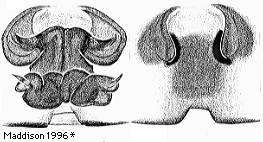 4
4
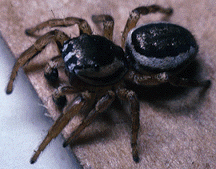 5
5
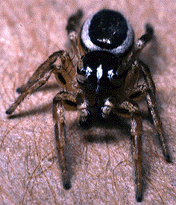 6
6
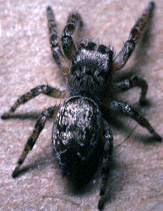 7
7- Male face
- Palpus
- Female abdomen
- Epigynum
- Male (Edmonton, AB)
- Male (Edmonton, AB)
- Female (Edmonton, AB)
Natural History
A conifer dweller, collected from spruce (11 records from Ontario, Manitoba, Alberta), including white spruce (2 records); pines (4 records from Ontario, British Columbia, Michigan), including lodgepole pine (1 record) and jackpine (1 record); junipers (3 records from Ontario); and larch (2 records from Ontario and Illinois).Distribution
Across much of Canada and Northeastern United States, south along the Rocky and Appalachian Mountains.About This Page
Included on this page are images and text from Maddison, W.P. 1996. Pelegrina Franganillo and other jumping spiders formerly placed in the genus Metaphidippus (Araneae: Salticidae). Bulletin of the Museum of Comparative Zoology. l54(4): 215-368. These images and text are copyright © 1996 The President and Fellows of Harvard CollegePage copyright © 1995 Wayne Maddison
All Rights Reserved.
Citing this page:
Tree of Life Web Project. 1995. Pelegrina flavipedes . Version 01 January 1995 (under construction). http://tolweb.org/Pelegrina_flavipedes/5057/1995.01.01 in The Tree of Life Web Project, http://tolweb.org/






 Go to quick links
Go to quick search
Go to navigation for this section of the ToL site
Go to detailed links for the ToL site
Go to quick links
Go to quick search
Go to navigation for this section of the ToL site
Go to detailed links for the ToL site